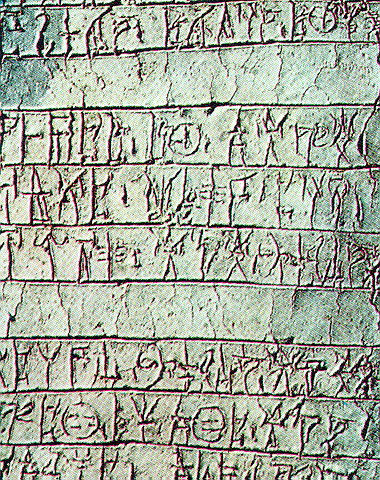Linear B Tablet From Pylos
Recording Offerings to Several GodsThe first step in the decipherment was to distinguish the ideograms from the syllabic signs; this was done by studying the pattern of recurrence (done by Bennett) and the totaling formula (done by Kober). Next was to inventory the syllabic signs. There proved to be about 85 of them (some rare), suggesting not an alphabetic but a syllabic script, in which each sign stands for a CV or consonant plus vowel combination. Third, and this is where Ventris came in, was to arrange the syllabic signs according to constraints on their solution, those suspected of having the same vowel being arranged in a vertical column, and those suspected of having the same initial consonant being arranged in a horizontal row. This Ventris called a grid:
A Schematic Version of the Ventris Grid
Columns Have the Same Vowel, Rows Have the Same ConsonantWhat was needed next was a lucky guess about the phonetic value of some frequently recurring sequence of signs. The names of the cities at which tablets had been found (Knossos, Pylos) were an obvious possibility, and this apparently was what Ventris used as his homemade "Rosetta stone" or bilingual key. Once the values of the signs apparently spelling these cities (Knossos = "ko-no-so," Pylos = "pu-ro") had been conjectured, the values of vowels for all signs in columns 4 ("o") and 5 ("u") became fixed, as did the consonantal values of the "k," "n," "p," "r," and "s" rows (only the "k" row is shown in the simplified diagram above). Notice that, even without a keyword, the absence of a symbol in column 3 of row 3 invites the hypothesis that this combination is impossible or redundant. In the latter case, we would we look for a vowel that is functionally indistinguishable from a consonant. The commonest example, in languages generally, is vowel "i" and its consonantal counterpart "y." This conjecture supplies the consonant of row 3 and also the vowel of column 3. This angle of approach does not seem to have been used in the actual decipherment.
The grid thus serves as a multiplier of the information available from the identification of one or two words (or the identification of one syllable), and if a mistaken identification leads nowhere, it will quickly reveal that fact. This acceleration of the hypothesis testing process is one of the most important functions of the grid. It is only if the implicated syllabic values also yield sense when reapplied to the tablets that a first identification is confirmed, and if it is, other identifications will rapidly follow. This is what happened, during late May and early June 1953, in Ventris's decipherment.
Ventris's series of grids became progressively better, prior to the breakthrough, but even the final version was imperfect, and now, fifty years later, there are still substantial areas of the tablets that cannot be read. What can be read is nevertheless sufficiently convincing that we may be confident that the general solution has been found, even if that solution does not carry with it a complete knowledge of the archaic Greek language, and the partly alien culture, of the Mycenaean age.
1 Dec 2005 / Contact The Project / Exit to Philology Page

